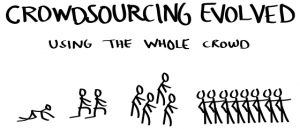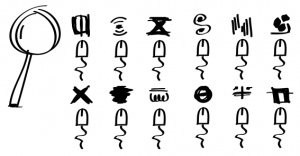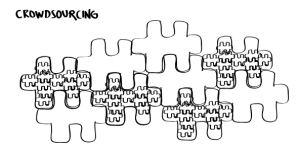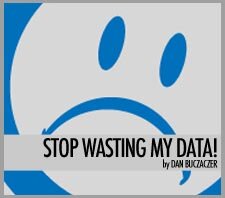Crowdsourcing Evolved: Using the Whole Crowd
Posted by Len Kendall | August 3, 2010
(The following is courtesy of guest denuologist Len Kendall co-founder of the 3six5)
There are about 3% of you reading this post that have never heard of crowdsourcing before. For that small subset let me give you a quick, recently Google’d explanation of what the crowdsourcing concept is all about. (Why 3%? Because 3 is a crowd)
Crowdsourcing is a term attributed to Jeff Howe from his 2006 Wired article titled, “The Rise of Crowdsourcing.” It’s most commonly referenced among marketing and design endeavors which leverage the willingness of many individuals to produce a final product based on the best contributions among those individuals.
What do I know about crowdsourcing?
Other than what Google taught me, not much. But if I may, I will suggest that I do have a bit of real world advice to offer based on two humble projects I’m a part of.
First off is the3six5 which is a crowdsourced diary of 2010. Along with co-founder Daniel Honigman we set out to tell the story of an entire year, day-by-day by having a different individual offer their personal account of their specific 24 hour period. Now just over half-way through, I’ve witnesses many successes and failures with the challenge of managing a process that requires 365+ prompt individuals to perform their duty in order to avoid dooming the final product.
My second most common exposure to crowdsourcing is my management of the ongoing “Doodles” project for GOOD Magazine. This fairly simple section of GOOD asks readers to take a broad theme or question that I provide to them, and sketch, draw, scribble, or doodle whatever comes to mind about the topic. While one submission is ultimately deemed the “winner” and given a free subscription and t-shirt, the real prize is participants chance to showcase their creativity to literally millions of people. This prize is offered to far more participants than just 1, and a
s time goes on, other platforms for sharing these illustrations will be developed (more on this later).
Current Crowdsourcing formula’s are NOT broken

This post is not meant to diminish current crowdsourcing efforts, especially in the field of design. It would be unfair to refer to such marketplaces as “un-evolved” for that isn’t the case. Rather, their potential for growing is lower than other creative categories. But a lower potential does not equate to unsuccessful. A bird flying above an African savannah may have less potential strength than a rhino, but it is no less interesting or important to the ecosystem that both creatures live in.
Sites like Threadless and Crowdspring have proven that a winner-take-all formula can be incredibly lucrative. And ethical questions aside, (there are plenty of blog posts covering either side of that debate) these sites are reaching millions of individuals and clearly producing revenue for their owners and many of their participants. They’re simply, brilliant, and people love the work that’s coming from them.
If it ain’t broke, just copy it?
There’s a popular saying coined by a relatively unknown American businessman named Lance Bert that states, “If it ain’t broke, don’t fix it.” The challenge within the realm of crowdsourcing today is that organizations and product developers believe they can successfully replicate the above model, which is often used in the graphic arts field, for all other types of crowd-fueled content. Super-bowl commercials, industrial design, journalism, and even charity are all segments of crowdsourcing being explored which are operating under the premise of rewarding only the top tier. However, when a large group of individuals is sorted through and only a select few are rewarded, what you have essentially is a contest.
The problem with this scenario isn’t the contest necessarily, but rather that the contest is often an all-or-nothing reward for its participants. 99% of the individuals who are interested in supporting your project, are ultimately turned away with nothing to show for their efforts. One could argue that this isn’t truly sourcing the crowd, but sifting. The shame here is that many of the individuals in that 99% (that were turned away) may have been valuable contributors to the project, but there simply aren’t enough spots, rewards, or managers for them all to participate.
Thus “the best” of the crowd, much like college applicants are selected through a seemingly mathematical process and their talented contributions are used. Perhaps even a long-term relationship is struck moving forward. But one has to wonder, is getting “level-10″ work from the top few percent, really better than getting 6,7,8, or 9-level work from the top 50 or 60%?
Use the alphas, AND betas, and gammas, and deltas…

In complex crowdsourcing projects, and when I say complex I’m speaking of the projects beyond a simple transaction of “I need this widget, let me look at all your proposed widgets, and then decide on the one I want,” there is a big opportunity to use the talents outside your own domain. Many companies don’t want to extend thinking and execution beyond their walls, and that’s fine. But one does have to question their motives for being involved in crowdsourcing in the first place. If they’re a part of a highly visible crowdsourced campaign that only grants creative privileges or access to one specific part of their company or project, is this method of collaboration then being leveraged out of a desire to gain fresh insights, accomplish work that can’t be resourced internally, or simply something to garner publicity?
One thing I’ve learned is that people don’t like velvet ropes. Everyone shows up wanting to have a good time, and putting them behind a rope doesn’t help them, it helps you. It creates an aura of exclusivity, and mystery. But in crowdsourcing, you are not the one doing the bulk of the work, the people you’ve invited to your doorstep are the ones doing the work. Give everyone who truly is passionate about being a part of your project the option to be part of it. In other words, use the crowd. If you have a finite number of spots, functions, or products you need the crowd to produce, find other ways to reward their enthusiasm. Offer them a spotlight, ask them specifically to participate in your next project, write them a note, or best of all, find new after-market contributions they can be part of. There are countless things that can be offered as rewards that don’t require anything but a bit of time. (If you think crowdsourcing is meant to save you time, you should stop implementing it immediately)
The Gist. Read this if you don’t have time to digest the entire piece.
-Use as many members of the crowd as you can when creating a crowdsourced project.
-If possible, set it up so the crowd’s efforts result in the majority of the output/input (and not that of the managers)
-Think beyond a single component. Think about the entire engine and how people can work together to contribute their particular best skills instead of one person contributing the best overall.
-Distribute the wealth. A lot of “great” contributions coming from smaller bits of compensation are better than only “the best” work coming from a large lump sum.
-Establish a community of peers, not competitors. If many people get a stake, a say, a forum, etc to express themselves, then they will support each other. Human nature doesn’t push us to help those we’re in direct competition with for the same resources.
Why I’m wrong. The big flaw.

Here’s something you learn extremely quickly when you start using the entire (or big portion of) crowd instead of just the best. You’ve got a lot of contributions that aren’t very good, or even usable. There will be people who offer very little value to your project. For whatever reason (they know you, like you, like the idea, boredom) they chose to participate in your project and send you something that clearly indicates they didn’t bother understanding your directions or exert any time/effort.
But this major flaw does have a solution. One that our friend Google has mastered splendidly: optimization. You’re often going to get 3 categories of participants in crowdsourced projects.
1) The people who think your product/project is great and are going to try their hardest to make sure they’re part of it, and that their work is visible to the world.
2) People who have the talent to give you what you want, but aren’t quite familiar with your product, or simply don’t have a great passion for it.
3) People who aren’t planning on putting much time or effort into output for you, but will “play the game” anyways because much like the lottery, if you don’t buy a ticket, you’ll never win.
The optimization comes from how the crowd managers reward their contributors on an ongoing basis. When the project is taking place and submissions are rolling in, the best of the best should be highlighted and encouraged. Their brilliant work (whether it’s selected in the end or not) should be showcased to the entire community so that visibility becomes another reward that’s being created. And believe me, visibility can often be a very motivating prize.
Optimization also comes from pushing those individuals in category 2. They may often be more talented than the most passionate individuals in tier 1, they just need to be pushed. They may be too busy, too indifferent, or misguided, but those middle-tier crowds can be turned into valuable participants if they get a bit more attention from you.
Optimize by knowing how to say no politely. The people who don’t care about your project and are submitting worthless contributions aren’t going to be offended when they are turned away. But there will be a subset of people who love you and your product, but simply don’t have the talent to give you the work that you need. Be gentle when you decline their efforts. No matter how worthless their work is to you, it took them time and effort and when possible, their true talents should be explored to see if their passion can be utilized elsewhere on your project. And don’t get scared that bringing all these folks in will require more rewards. If they’re truly interested in being part of the project, your personal acknowledgement and request for their input, may be enough to bring in a new, uncompensated fan.

Related Posts
4 Responses to “Crowdsourcing Evolved: Using the Whole Crowd”
Leave a Comment
RSS feed for comments on this post · TrackBack URI



[...] This post was mentioned on Twitter by Len Kendall, Brian Hayashi. Brian Hayashi said: RT @LenKendall: Crowdsourcing Evolved: Using the Whole Crowd: http://bit.ly/aV8C2x [...]
Len, great post. Thanks for sharing your perspective on crowdsourcing based on experience. I hear way too much opinion without experience.
Next I think you’ll want to start building tools to make crowdsourcing into a series of curated feedback loops that drive an ongoing engine of creativity and engagement.
At least that’s what we found we had to do next.
Hey Len,
Caught you on a search for bloggers writing about crowdsourcing. I wanted to introduce myself as the co-founder of a site dedicated to crowdsourcing scripts for the entertainment industry. We’re changing the way Hollywood does business and I’d love to tell you more about it.
Can I introduce you to my business?
Thanks,
Ryan
Scripped.com
Great post.
One part of crowdsourcing that isn’t discussed often is the crowdsourcee– the one who starts the project.
There are times when it is a small business or a personal project. Time when the crowdsourcee is deeply vested and makes decisions based on the big picture. I do not speak of those times.
I speak of times when larger organizations use crowdsourcing. There are key characteristics and needs one must have. They need to discipline to differentiate between a good idea and the right idea. They need to accept that they can’t do (most of the time) what they are asking the crowd to do. I see, all to often, the abuse of the crowd.
I have a few thoughts, but would love to hear others in terms of the rules of engagement for the crowdsourcee… the oath you take prior to starting a project? and who, if they aren’t ready to commit, should avoid sourcing the crowd.